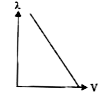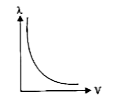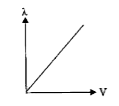Show graphically, the variation of the de-Broglie wavelength (λ) with the potential (V) through which an electron is accelerated from rest.
Ad de-Broglie wavelength λ of an electron accelerated with a potential of V is given by:
λ=h√2emV, hence λ−V graph is shown in figure

Topper's Solved these Questions
- DUAL NATURE OF RADIATION AND MATTERBOOK - U-LIKE SERIESCHAPTER - DUAL NATURE OF RADIATION AND MATTEREXERCISE - SHORT ANSWER QUESTIONS
27 Videos
- DUAL NATURE OF RADIATION AND MATTERBOOK - U-LIKE SERIESCHAPTER - DUAL NATURE OF RADIATION AND MATTEREXERCISE - LONG ANSWER QUESTIONS
19 Videos
- DUAL NATURE OF RADIATION AND MATTERBOOK - U-LIKE SERIESCHAPTER - DUAL NATURE OF RADIATION AND MATTEREXERCISE - ASSERTION REASON TYPE QUESTIONS
5 Videos
- CURRENT ELECTRICITY BOOK - U-LIKE SERIESCHAPTER - CURRENT ELECTRICITY EXERCISE - SELF ASSESSMENT TEST (SECTION C )
3 Videos
- ELECTRIC CHARGES AND FIELDS BOOK - U-LIKE SERIESCHAPTER - ELECTRIC CHARGES AND FIELDS EXERCISE - SELF ASSESSMENT TEST (SECTION-B) (VERY SHORT ANSWER QUESTIONS)
4 Videos
Similar Questions
Show graphically, the variation of the de-Broglie wavelength (λ) with the potential (V) through which an electron is accelerated from rest.
View SolutionShow graphically, the variation of the de-Broglie wavelength λ with the potential V through which an electron is accelerated from rest.
View Solution
Knowledge Check
Which of the following graphs shows the variation of de-Broglie wavelength with potential through which a particle of charge q and mass m is accelerated ?
A B
B C
C D
D
The de Broglie wavelength λ of an electron accelerated through a potential V in volts is
A1.227√VnmB0.1227√VnmC0.01227√VnmD12.27√VnmThe de Broglie wavelength λ of an electron accelerated through a potential V in volts is
A1.227√VnmB0.1227√VnmC0.01227√VnmD12.27√Vnm
On the basis of the de Broglie hypothesis, obtain the expression for the de Broglie wavelength associated with an electron accelerated from rest through a p.d. V.
View SolutionWhat is the de-Broglie wavelength associated with an electron accelerated through a potential of 100V ?
View SolutionAn electron of mass 'm', when accelerated through a potential V has de-Broglie wavelength λ. The de-Broglie wavelength associated with a proton of mass M accelerated through the same potential difference will be:
View SolutionA chemist was performing an experiment to study the effect of varying voltage on the velocity and de Broglie wavelength of the electrons. In first experiment, the electron was accelerated through a potential difference of 1kV and in second experiment, it was accelerated through a potential difference of 2kV.
The wavelength of de Broglie waves associated with electron is given by:
λ=h√2qVm
where, V is the voltage through which an electron is accelerated.
Putting the values of h, m and q we get:
λ=12.3√VÃ…
Q. The wavelength of electron will be:
View SolutionA chemist was performing an experiment to study the effect of varying voltage on the velocity and de Broglie wavelength of the electrons. In first experiment, the electron was accelerated through a potential difference of 1kV and in second experiment, it was accelerated through a potential difference of 2kV.
The wavelength of de Broglie waves associated with electron is given by:
λ=h√2qVm
where, V is the voltage through which an electron is accelerated.
Putting the values of h, m and q we get:
λ=12.3√VÃ…
Q. The velocity of electron will be:
View Solution
